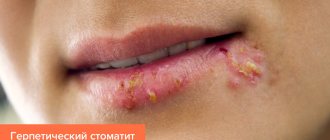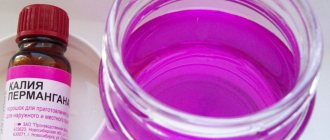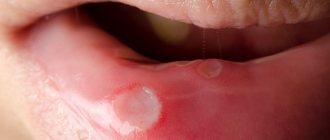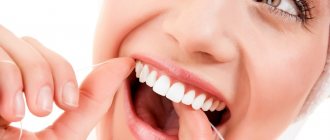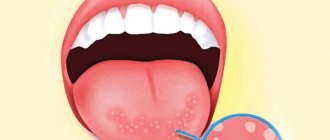Most aphthous ulcers (symptoms of so-called aphthous stomatitis) heal quickly. Pain may be relieved in about seven to ten days, and full recovery takes one to three weeks. Most often, ulcers do not require additional treatment. However, if they appear constantly or are too painful, you should consult a dentist.
This is what aphthous stomatitis looks like in adults
Causes of aphthous stomatitis
While scientists haven't fully determined what actually causes painful mouth ulcers, they have found that a variety of factors and medical conditions can cause them. Certain events or environmental characteristics, emotional changes, or dietary changes can increase the risk of canker sores. And:
- oral injury due to dental procedures, rough brushing, sports-related injuries, and unintentional cheek biting;
- dental care products containing sodium lauryl sulfate;
- food sensitivity or allergic reactions to chocolate, coffee, strawberries, eggs, nuts, cheese, spicy or sour foods;
- deficiency of vitamin B12, zinc, iron, folate or folic acid;
- allergy to microorganisms that multiply in the oral cavity;
- Helicobacter pylori - bacteria that cause ulcers;
- hormonal changes during menstruation;
- emotional stress.
Diseases that increase the tendency to develop aphthous stomatitis:
- Celiac disease. This is a serious intestinal disorder that is caused by intolerance to gluten, one of the proteins present in grains. Aphthous ulcers are a known hallmark of this disease.
- Diseases associated with intestinal inflammation are Crohn's disease and ulcerative colitis . Be aware that ulcers are common symptoms of these conditions, especially Crohn's disease. You may notice that their development often coincides with periods of exacerbation, but the ulcers usually heal once the patient's condition is under control.
- Behçet's diseases . People with this rare disorder experience inflammation of blood vessels throughout the body, including the mouth, and mouth ulcers, which are sometimes the main symptom of the disease. At first they look like raised round blisters, but gradually turn into ulcers. Healing often takes one to three weeks, and outbreaks of ulcers may be recurrent.
- Improper functioning of the immune system . If your immune system is weakened, healthy cells in your mouth may be attacked by antibodies instead of harmful pathogens, viruses and bacteria. Although a reliable connection between canker sores and a weak immune system has not yet been fully proven, it is known that in immunocompromised patients the recovery period from them takes much longer than in those with strong immune systems.
- HIV AIDS . This disease, caused by the human immunodeficiency virus (HIV), attacks the immune system and leads to, among other things, dental problems. Specifically, patients develop canker sores and other symptoms such as tooth decay, dry mouth, and gum disease (periodontitis).
Using medications to treat canker sores
Find out which common medications prescribed to get rid of canker sores are best to stay away from.
Side effects of common medications
Here are a few medications often recommended for this condition. However, be careful as there are potential health risks associated with taking them.
1. Mouthwashes containing the corticosteroid dexamethasone. Corticosteroids cause a variety of side effects, and dexamethasone is no exception. The list of negative consequences of taking it includes:
- vision problems;
- swelling;
- weight gain;
- sleep problems such as insomnia;
- changes in mood;
- acne;
- dry and thin skin;
- bruising and skin discoloration;
- headache;
- dizziness;
- nausea;
- stomach ache.
2. Topical over-the-counter and prescription medications such as pastes, creams, gels, or liquids whose active ingredients are benzocaine (a local anesthetic) and fluocinonide (another steroid). Read the list of possible side effects that may occur as a result of their use.
Benzocaine:
- allergic reactions such as burning, itching, peeling and the appearance of dry white scales on the surface of the skin;
- breathing problems;
- dizziness;
- fast heartbeat;
- headache;
- restlessness, nervousness or anxiety;
- weakness.
Fluocinonide:
- dry or cracked skin;
- itching and burning;
- changes in skin color;
- headache;
- severe rashes or redness, weeping and swollen skin;
- excessive hair growth;
- nausea or vomiting;
- inflamed hair follicles;
- hoarse voice.
These medications may also contain an ingredient called hydrogen peroxide. It is a well-known antiseptic that is effective against bacteria. Hydrogen peroxide destroys the membranes of bacterial cells by attaching their electrons. The enzyme attracts catalase located inside the bacteria, after which a reaction occurs between them, accompanied by hissing and the release of an oxygen molecule. However, the main problem with hydrogen peroxide is that it does not distinguish between healthy cells and pathogenic bacteria in a wound. This means that it can also take electrons from the membranes of healthy cells, destroying them and reacting with catalase.
Using too much hydrogen peroxide can cause excessive oxidative damage to cells, slow wound healing, and increase the risk of scarring. This substance is appropriate to use only if you need a powerful and effective antiseptic.
3. Oral medications. They are usually prescribed for severe ulcers that do not respond to current treatments. These drugs taken orally often cause enormous harm to the body, if only because they are not intended for such use at all. Two examples:
- Sucralfate, also called Carafate, is developed to treat intestinal ulcers. Typically used for gout, but may cause nausea, vomiting, stomach pain, headaches, or dizziness.
- Oral steroids prescribed for severe aphthous ulcers that have failed other treatments are considered a last resort due to the risk of severe side effects.
4. Cauterization of sores. This is a procedure in which an instrument or chemical is used to burn, scorch or destroy affected tissue. Cauterization is often recommended because chemical removal of the ulcer reduces the time it takes for it to completely heal to about a week. Debacterol is usually used during this procedure. This substance helps treat ulcers and other gum diseases. In some cases, silver nitrate is used for cauterization, but it only relieves severe pain and does not speed up the healing process. Silver nitrate is highly toxic and dangerous if swallowed.
Natural Ways to Relieve Canker Sore Pain
If the pain of canker sores is too much to bear, here are some of the most commonly used natural remedies:
- regular mouth rinse. Rinse the ulcers with salt water or baking soda solution, mixing 1 tsp. soda with half a glass of warm water;
- Magnesium hydroxide. Apply a small amount to the affected area several times a day;
- ice. Applying ice to ulcers helps relieve pain quickly;
- Coconut oil. It has anti-inflammatory and antimicrobial properties. Using a cotton swab or clean hands, apply a small amount to affected areas two or three times daily;
- honey. Raw organic honey is renowned for its potential antibacterial and anti-inflammatory properties. A 2021 study found that it reduced symptoms of one of the complications of chemotherapy and radiation therapy, induced oral mucositis.
- Apple vinegar. Combine equal parts apple cider vinegar and warm water. Rinse your mouth with this mixture and then spit it out.
You can also try alternative or naturopathic treatments for canker sores, but you should consult your dentist first. Here are some of the potentially effective naturopathic remedies:
- Rhodiola rosea;
- smooth licorice;
- mahonia holly root;
- spilanthes flowers;
- common cuff leaves;
- myrtle leaves.
Because ulcers can develop due to a deficiency of nutrients such as zinc, vitamins B6 and B12, folic acid, or folate, your doctor may recommend taking supplements to boost your levels.
Moscow metro station Zvezdnaya, Danube Avenue, 23
Types of ointments
The main difference between drugs of this form lies in their composition - it is the properties of the main component that determine the ability of the drug to destroy one or several different pathogens. Based on this principle, four types of ointments have been developed against different types of this disease:
- for the treatment of herpes stomatitis resulting from damage to the body by a virus;
- against aphthous stomatitis associated with poor oral hygiene (considered the most common form of the disease);
- for the treatment of candidal stomatitis, which is often found in children and has another common name - “thrush”;
- universal drugs suitable for eliminating all types of stomatitis.
However, to decide what to apply to a child’s stomatitis, knowing only the main effect of the main component is not enough. Therefore, to choose the right ointment, you need to familiarize yourself with the most popular ones.
Holisal
Cholisal is a universal ointment suitable for the treatment of all types of stomatitis, including fungal. It is capable of providing local analgesic, antipyretic and anti-inflammatory effects. Prescribed primarily for children over 1 year of age.
- Ingredients: Cetalkonium chloride and Choline salicylate.
- Application : apply 2-3 times a day after meals, as well as at night. To treat a child, squeeze 5 mm of ointment onto a clean finger and rub it into the affected areas of the oral cavity.
- Contraindications : intolerance to salicylates and other components. Not recommended for treating children under 1 year of age.
Oxolinic ointment
A drug based on oxoline (0.25%) is an effective remedy for getting rid of stomatitis caused by herpes viruses, influenza and adenoviruses. It is especially often prescribed to neutralize this disease in a child.
- Composition : Oxolin.
- Application : a certain amount of ointment is rubbed into the affected areas of the oral cavity 2-3 times a day.
- Contraindications : oxolin-containing products are prohibited for use in the presence of any drug allergies.
Bonafton
This drug has an antiviral effect and is intended to combat stomatitis caused by the Herpes simplex virus and adenoviruses.
- Ingredients : Bromonaphthoquinone.
- Application : a small amount of the product should be applied to the affected areas 3-4 times a day and left for a maximum of 5-10 minutes.
- Contraindications: the drug is contraindicated for use if the child has a hypersensitivity to its components.
Acyclovir ointment
It is one of the drugs prescribed for the treatment of herpetic stomatitis in a child.
- Composition : thymidine nucleoside analogue of synthetic origin.
- Application : acyclovir ointment should be rubbed into the surface of the affected areas every 4 hours. The duration of treatment is determined by the pediatrician individually.
- Contraindications : the presence of individual intolerance to the constituent ingredients.
Tebrofen ointment
It has antiviral properties and is prescribed to combat stomatitis caused by various types of viruses.
- Composition: Tetrabromotetrahydroxydiphenyl.
- Application : a certain amount of 2% ointment is applied to the inflamed areas 3 times a day. The course of treatment is 1 week.
- Contraindications: increased sensitivity to the components of the ointment.
